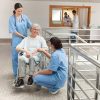Orthopedic Equipment
Correcting certain orthopedic conditions may call for the help of additional equipment specially designed for such purposes. These orthopedic devices or equipment help by stabilizing, protecting and correcting disorders thereby speeding up the healing process. It is critical that these belong to a reputable medical supplies brand to ensure its effectiveness. Orthopedic equipment is either bought as over-the-counter products while some are custom made to suit specific individuals or conditions.
Orthopedic equipment can include a wide range of braces, internal supports, and other devices. While some could be placed internally other types are used externally and can be easily removed when unnecessary. External equipment provides comfort when sleeping and makes bathing easier. Orthopedic equipment is not just used by seniors, anyone affected by musculoskeletal injuries will need them even kids suffering from birth defects or sporting injuries. You may have come across such devices being used for conditions like clubfoot, Kohler's Disease, Sever's Disease or Sprengel's Deformity. Let’s look at some of the commonly used orthopedic equipment and their functions.
Internal Orthopedic plates and rods – These can help to permanently reinforce the bones and connective tissue following a traumatic injury or to treat genetic physical deformities. Replacement joints used in surgical procedures also belong to this category.

Ice packs and heating pads - These belong to the category of orthopedic therapy tools. Ice packs are used for acute injuries whereas heating pads are used for chronic injury to relax underlying tissues and reduce inflammation. Some conditions may require both cold and heat therapy alternatively.

Knee braces – These functional braces can help with knee injuries like ACL tears and wearing these can allow the patient to resume normal activities while protecting the knee.

Prophylactic knee braces – Such braces often used by athletes are designed to prevent injury during sporting events.

Walking aids - Walkers or canes or even wheelchairs can help in post-operative recovery after orthopedic procedures.

Braces – These orthopedic devices allow flexibility and offer stability to joints like ankles, wrists or elbows. They can be used externally and can be easily removed when they are not needed.

Back braces – Back braces provides extra support to the back after an injury, restrains it from moving too much and also helps to promote good posture.

Orthopedic Shoes, Socks & Hosiery – These offer support to the feet and ankles and provides compression, comfort, relieves fatigue, and prevents varicose veins. The shoes reduce pressure points on the joints while supporting proper shape to the foot. They are great for diabetics that suffer from poor circulation and prone to infections.

Orthopedic devices for pregnancy – Certain orthopedic devices could help ease the discomfort of pregnancy like special belts to support the belly and reduce strain on the back by providing lumbar and abdominal support. Orthopedic socks can help reduce feet swelling.

Soft cervical collars – These neck braces help to prevent or minimize motion in the cervical spine and keeps the head in a comfortable position. Can be used for conditions like neck extension injuries (Whiplash), cervical Spondylitis, Spondylosis and the herniated Cervical Disc.

Forearm Splint Brace – This is especially be useful for those who repeatedly use their wrists, mainly for powerful and fast movements and it can help with conditions like Carpal tunnel syndrome, Wrist instability, Rheumatoid arthritis, Redial Nerve Paralysis.

For enquiries and bookings, call 9400630000, Whatsapp – 9447771361 or send an
email to MediTvm@gmail.com





